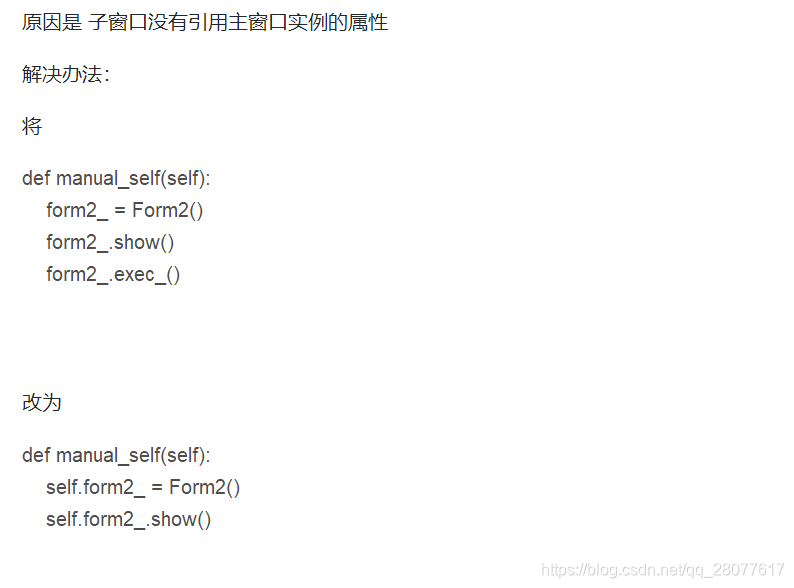需求:
在PYQT5中,点击主窗口中的按钮,弹出子窗口。
测试代码:
例1:
from PyQt5.QtWidgets import *
import sys
class Main(QMainWindow):
def __init__(self):
super().__init__()
self.setWindowTitle("主窗口")
button = QPushButton("弹出子窗", self)
button.clicked.connect(self.show_child)
def show_child(self):
child_window = Child()
child_window.show()
class Child(QWidget):
def __init__(self):
super().__init__()
self.setWindowTitle("我是子窗口啊")
# 运行主窗口
if __name__ == "__main__":
app = QApplication(sys.argv)
window = Main()
window.show()
sys.exit(app.exec_())
运行结果: 该段代码运行后,点击主窗口中的按钮,子窗口一闪而过。
例2:
在主窗口添加按钮,并把按钮信号关联槽,在槽函数中创建子窗口对象并赋值为对象属性,并调用其 show 方法。
from PyQt5.QtWidgets import *
import sys
class Main(QMainWindow):
def __init__(self):
super().__init__()
self.setWindowTitle("主窗口")
button = QPushButton("弹出子窗", self)
button.clicked.connect(self.show_child)
def show_child(self):
self.child_window = Child()
self.child_window.show()
class Child(QWidget):
def __init__(self):
super().__init__()
self.setWindowTitle("我是子窗口啊")
# 运行主窗口
if __name__ == "__main__":
app = QApplication(sys.argv)
window = Main()
window.show()
sys.exit(app.exec_())
运行结果: 该段代码运行后,点击主窗口中的按钮,子窗口正常打开,重复点击按钮,子窗口重复弹出。
例3:
在主窗口init方法中创建子窗口对象并赋值为对象属性,添加按钮,并把按钮信号关联槽,在槽函数中调用子窗口对象的 show 方法。
from PyQt5.QtWidgets import *
import sys
class Main(QMainWindow):
def __init__(self):
super().__init__()
self.setWindowTitle("主窗口")
button = QPushButton("弹出子窗", self)
button.clicked.connect(self.show_child)
self.child_window = Child()
def show_child(self):
self.child_window.show()
class Child(QWidget):
def __init__(self):
super().__init__()
self.setWindowTitle("我是子窗口啊")
# 运行主窗口
if __name__ == "__main__":
app = QApplication(sys.argv)
window = Main()
window.show()
sys.exit(app.exec_())
运行结果: 重复点击按钮,子窗口不重复弹出。
例4:
把例1的show()方法改为exec()方法
from PyQt5.QtWidgets import *
import sys
class Main(QMainWindow):
def __init__(self):
super().__init__()
self.setWindowTitle("主窗口")
button = QPushButton("弹出子窗", self)
button.clicked.connect(self.show_child)
def show_child(self):
child_window = Child()
child_window.exec() ############# 请注意这里
class Child(QWidget):
def __init__(self):
super().__init__()
self.setWindowTitle("我是子窗口啊")
# 运行主窗口
if __name__ == "__main__":
app = QApplication(sys.argv)
window = Main()
window.show()
sys.exit(app.exec_())
运行结果:出现错误,如下所示。
我用的是PyCharm 2021.2(community edition) + PyQt5 15.5.4 ,怎么就会出错了呢?于是乎我开始在网上找答案,其中一个解决方法如下:

按照这个做出如下修改:
# 这是原来出错部分的代码
def show_child(self):
child_window = Child()
child_window.exec() ############# 请注意这里
# 将上面部分修改成以下样子
def show_child(self):
self.child_window = Child() # 注意,这里只是在原来的基础上加上了self
self.child_window.show() # 这里只是将exec()换成了show(),并在前面加上self
结论:
例2比例1仅仅多了一个self怎么就运行正常了呢?
例4与例1仅改了一个方法怎么又能正常显示了呢?
这里涉及到一个概念 模式对话框 与 非模式对话框 (modeless dialog | modal dialog)
模式对话框,就是在弹出窗口的时候,整个程序就被锁定了,处于等待状态,直到对话框被关闭。这时往往是需要对话框的返回值进行下面的操作。如:确认窗口(选择“是”或“否”)。
非模式对话框,在调用弹出窗口之后,调用即刻返回,继续下面的操作。这里只是一个调用指令的发出,不等待也不做任何处理。如:查找框。
show() —— modeless dialog
exec() ——- modal dialog
-
例1中 子窗口 通过 show()
方法显示,为非模态窗口,它的实例为父窗口show_child()方法中的局部变量,当窗口显示后,父窗口的show_child()方法继续执行,当方法运行完后,python的回收机制就把局部变量销毁了,相当于子窗口实例被销毁,故子窗口一闪而过; -
例2中 子窗口实例为主窗口类的变量,当show_child()方法运行完后,主窗口对象依旧存在,子窗口实例也存在,故子窗口正常显示,但是每一次运行槽函数都会重新创建子窗口对象;
-
例3中 子窗口实例为主窗口类的变量,当show_child()方法运行完后,主窗口对象依旧存在,子窗口实例也存在,故子窗口正常显示,每一次show_child()函数,重新调用子窗口对象show_child()方法,不会创建新窗口,且可随意在父,子窗口间切换;
-
例3中 子窗口 通过 exec()方法显示,为模态窗口,虽然他为父窗口show_child()方法中的局部变量,由于阻塞的机制,父窗口show_child()并没有继续执行,故其不会像例1 中 一闪而过,且不能在父,子窗口间切换;
参考链接:
1、https://www.jianshu.com/p/4c76b2bcb230
2、https://blog.csdn.net/qq_32856147/article/details/79646163
